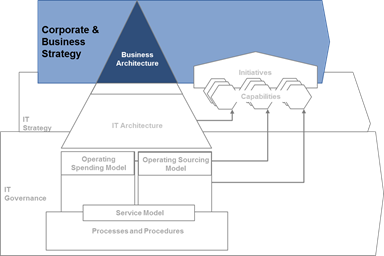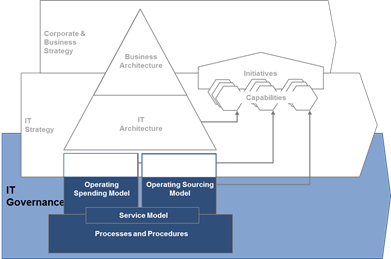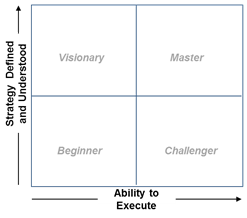The Business Architecture is the most dominant architecture; all other architectures can be derived out of the business architecture and should be traceable back to the business architecture.
Although any model is an abstraction of some reality, the Business Architecture should be the most tangible representation of reality in business terms. It provides the business rules and requirements for building all other architectures. This architecture layer maintains the links back to the corporate strategy and keeps the whole enterprise focused; in this way it provides an excellent feedback mechanism for additional business improvements and opportunities for building a competitive advantage.
Business architecture defines the enterprise value chain (or process streams) and their relationships to all enterprise and external business entities. It is a definition of what the enterprise must produce and how it produces to satisfy its customers, compete in a market, deal with its suppliers, sustain operations and care for its employees.
This business architecture can be described in terms of three key models; these three models are often used interchangeably to describe a Business Architecture but are actually quite different. They provide different perspective on the business and sometimes are overlapping each other:
- a Business Model describes how the enterprise business works; it is more focused on the external relationships and interaction between the company, partners and customers
- a Business Operating Model describes the necessary level of business process integration and data standardization in the business and among all internal and components of the company; it is more focused on the internal relationships and interaction between the companies departments and how they cooperate together to operate the business
- a Capability Model describes the capabilities required to implement the Business and Operating Model
The business model of a company is a simplified representation of its business logic meaning that it describes the rationale of how an organization creates, delivers, and captures value; It defines the manner by which the business enterprise delivers value to customers, attracts customers to pay for value, and converts those payments to profit.

Even if this term is used for a broad range of descriptions to represent core aspects of a business (including purpose, offering, market, customers,…) the essence of a business model is that it describes what a company offers its customers, how it reaches them and interacts with them, through which resources, activities and partners it achieves this and finally, how it earns money.
In the early history of business models it was very typical to define business model types, however, these types usually describe only one aspect of the business, most often only the revenue model. Therefore, more recent literature on business models concentrates on describing business model as a whole instead of one only elements. Inspired by the “Business Model Canvas” framework, a business model design should include the description of the following key elements:
- “Target Customer Segments” element defines the different groups of people or organizations an enterprise aims to reach and serve
- “Value Proposition” element describes the bundle of products and services that create value for a specific Customer Segment
- “Distribution Channels” element describes how a company communicates with and reaches its Customer Segments to deliver a Value Proposition
- “Customer Relationships” element describes the types of relationships a company establishes with specific Customer Segments value configurations
- “Key Resources” element describes the most important assets required to make a business model work
- “Key Activities” element describes the most important things a company must do to make its business model work
- “Key Partners” element describes the network of suppliers and partners that make the business model work
- “Revenue Stream” element represents the cash a company generates from each Customer Segment
- “Cost Structure” element describes all costs incurred to operate a business model

All these elements of the Business Model should be mixed together in a value stream or value chain which describe the sequences of steps in the organization which allow to create the value and this part will be described in the Operating model.

An Operating Model describes how internally you want your business to run; it defines the major operational elements required to implement your business model; and how each of them is linked and further designed in terms of sub components. In this sense an Operating Model is usually informed and derived by the Business Model; however in some cases, an Operating Model can become the source of competitive advantage and can inform the Business Model.
An Operating Model breaks the company organization down into its logical components and describe how the organization does business, it illustrates the key areas of the organizational structure, the relationships among the operating units and trading partners and provides a set of guidelines for both the business architecture and technology infrastructure that enable a company to grow its business.

An operating model should answer at some operational questions about the company internally runs, such as “What is the organization structure?”, or “What processes does the organization use?” and “What are the roles and responsibilities?” trying to highlight main components and relationships of an Operating Model framework which are:
- People components which include structure, organization, skills, knowledge culture, governance, rewards, sourcing and locations
- Supporting Infrastructure and Facilities components which include physical assets, facilities and locations, information and data assets, technological infrastructures and application (that partially have been described in more detail in the IT Architecture)
- Processes components include the overall process flows, inputs, outputs, accountability (who does what), where, how, what metrics and what levels of consistency
Capability modeling is a technique for the representation of the internal side of an organization’s business, independent of the organization’s structure, processes, people or domains; it describes the complete set of capabilities an organization requires to execute its business model or fulfill its mission.
A Capability is a particular ability or capacity that a company have to achieve a specific purpose or outcome. In this sense a capability abstracts and encapsulates the organization with the people and their roles, processes, procedures, and technology associated with a given business function into a simple block.

Capabilities in a Capability model are distinct from Processes in the Operating model; Capabilities are “WHAT” a business does to reach the desired outcomes, whereas processes describe “HOW” it is being done. The benefit is that a Capability model is much more stable over time and also much more static across businesses within the same sector, and thus a much more suitable business design components on which to pin the IT Architecture.
The key characteristics of a business capability, that distinguish the Capability Model from an Operating model, are the following:
- Each capability is unique and reusable. It is a fundamental element of the organization and as such is clearly different from other capabilities. A capability might be applied throughout the organization and may be applied in different ways to affect different outcomes but it is still a single capability.
- Capabilities are stable. Well-defined capabilities rarely change; they provide a much more stable view of organizations than do projects, processes, applications, or even strategies. Capabilities only change when there is a significant shift in the underlying business model or mission which might occur through a business transformation initiative or in conjunction with a merger or acquisition.
- Capabilities are abstracted from the organizational model. Capability models are not just a simple restatement of the enterprise’s organizational model. They are organizationally neutral which means that changes in the organizational structure don’t require a change in the capability model. In simple organizations, the capability model may look similar to the corporate organizational structure because organizations are typically built around common skills, but more complex organizations have same capabilities that appear in multiple functional groups.
- A business capability does not impose any constraints on how it has to be realized through IT systems or human actions.
Capability models are multilevel but the number of levels varies greatly from organization to organization depending on how the model is applied. Almost all have at least two levels with very few having more than five, containing a number of capabilities , at the lower level, ranging from 10-50.

Exhibit 19 – Business Capability model
At the high level (from level 1 and 2) the Capability model represent the 5-10 main generic capabilities of the organization, they are usually overlapping with the high-level process model or overlapping with the high-level product groups. Capabilities below level 3 of the hierarchy are primarily used to connect the model to processes and technologies.

Read more on this topic from my eBook…or stay tuned for new posts.




































